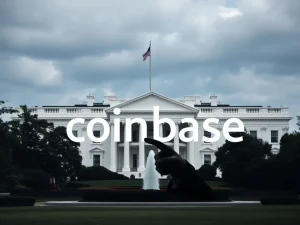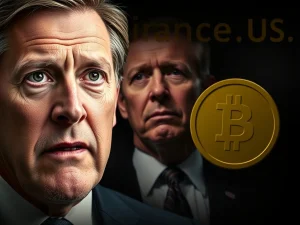Shocking Thailand Cambodia Conflict: Deadly Escalation in Emerald Triangle Claims 11 Lives

While the world of digital assets often feels like a universe unto itself, major geopolitical events ripple through global markets, sometimes in unexpected ways. Understanding these broader shifts is crucial for any informed investor, including those in crypto. Today, we turn our attention to a shocking development: the Thailand Cambodia conflict, which has dramatically escalated, underscoring the fragile nature of regional stability.
Thailand Cambodia Conflict: A Deep Dive into Escalation
On July 24, 2025, a long-simmering Thailand Cambodia conflict erupted into a dangerous exchange of air strikes and artillery fire. This escalation, rooted in a decades-old border dispute, tragically claimed at least 11 civilian lives, including students caught in a rocket attack in Thailand’s Sisaket province. The situation quickly spiraled:
- Thai military reported scrambling six F-16 jets to target Cambodian positions after Cambodian forces allegedly initiated fire near the border.
- Cambodia, in turn, accused Thailand of unprovoked aggression, asserting its right to self-defense under international law.
- The conflict reportedly began around 7:35 am local time, with Cambodian forces firing rockets and artillery into Thai territory following a skirmish near ancient temples in Surin and Oddar Meanchey provinces.
Both nations exchanged harsh words, with Thailand labeling Cambodia “inhumane and war-hungry,” while Cambodia criticized Thai “incursions” and sought an urgent UN Security Council meeting. This military escalation followed a significant diplomatic breakdown earlier in the day, triggered by a landmine attack that injured Thai military personnel. Thailand responded by expelling Cambodia’s ambassador and recalling its envoy, prompting Cambodia to retaliate by downgrading diplomatic ties.
The Emerald Triangle: A Flashpoint Unpacked
At the heart of this renewed tension lies the historically contested Emerald Triangle region. This vital area, where the borders of Thailand, Cambodia, and Laos converge, is not merely a geographical point but a strategic and culturally significant flashpoint. For over 15 years, the Emerald Triangle has been a site of sporadic clashes and unresolved border tensions. Its importance stems from:
- Geopolitical Significance: Control over the region offers strategic advantages in border security and regional influence.
- Cultural Heritage: Proximity to ancient temples, like those in Surin and Oddar Meanchey, adds a layer of historical and nationalistic pride to the claims.
- Resource Potential: While not explicitly mentioned in this instance, border regions often hold unexploited natural resources, adding to their strategic value.
The latest violence underscores the inherent fragility of regional diplomacy and the significant risks of miscalculation in Southeast Asia. The unresolved nature of these border lines makes any minor incident capable of igniting a broader conflict, as seen in this deadly exchange.
Understanding the Border Dispute: Historical Roots and Recent Tensions
The current border dispute is deeply rooted in historical claims and colonial-era mapping ambiguities that have plagued relations between Thailand and Cambodia for decades. While the precise demarcation of the shared 800-kilometer border has been a persistent point of contention, specific areas, often near ancient temple sites, frequently become flashpoints. The recent escalation was not an isolated incident but the culmination of rising tensions. The expulsion of ambassadors and the downgrading of diplomatic ties clearly indicated a severe breakdown in communication channels that could have otherwise de-escalated the situation. This diplomatic failure highlights the challenges in resolving long-standing territorial disagreements, particularly when compounded by domestic political pressures.
Geopolitical Tensions: Regional Reactions and Global Implications
The escalating geopolitical tensions have drawn swift reactions from regional and international actors, highlighting concerns about broader stability in Southeast Asia.
- ASEAN’s Role: As the regional bloc, ASEAN (Association of Southeast Asian Nations) faces a significant test of its mediation capabilities. While ASEAN chair Malaysia, through Prime Minister Anwar Ibrahim, called for dialogue, the deepening bilateral hostilities challenge the bloc’s effectiveness.
- China’s Influence: China, a close ally of Cambodia, has urged de-escalation and advised its citizens to avoid the Thailand-Cambodia border, indicating its vested interest in regional stability.
- Travel Advisories: Thailand’s embassy in Phnom Penh issued a travel advisory, urging its nationals to evacuate Cambodia, reflecting the severity of the perceived threat and growing regional instability.
The conflict also has domestic political implications within Thailand, where Prime Prime Minister Paetongtarn Shinawatra faces suspension amid an ethics probe. A leaked diplomatic conversation between her and Cambodia’s ex-leader Hun Sen further strained relations, demonstrating how internal political dynamics can exacerbate external conflicts. Analysts are closely watching for potential broader spillover effects, especially if ASEAN’s mediation efforts prove insufficient.
Navigating Southeast Asia Conflict: What’s Next?
The recent flare-up serves as a stark reminder of the volatile nature of unresolved territorial claims in Southeast Asia conflict zones. The immediate priority for all parties involved, and for the international community, is de-escalation and the establishment of effective communication channels to prevent further loss of life and wider destabilization. The long-term resolution of the border dispute will require sustained diplomatic efforts, potentially involving international arbitration or renewed bilateral negotiations with clear and enforceable agreements. The stability of the entire region hinges on the ability of these nations to move beyond historical grievances and work towards a peaceful resolution, ensuring the safety and prosperity of their citizens.
The tragic escalation of the Thailand-Cambodia border conflict in the Emerald Triangle is a sobering event, highlighting the dangers of unresolved territorial disputes and diplomatic breakdowns. With 11 lives lost and regional stability threatened, the international community is closely watching. While direct implications for cryptocurrency markets might seem distant, understanding such geopolitical shifts is vital for grasping the broader economic and political landscape that can indirectly influence global asset classes. The hope remains for a swift de-escalation and a return to dialogue to prevent further tragedy in this strategically important part of Southeast Asia.
Frequently Asked Questions (FAQs)
1. What caused the recent escalation between Thailand and Cambodia?
The recent escalation stemmed from a decades-old border dispute over the Emerald Triangle region. It was triggered by a border skirmish and alleged rocket and artillery fire from Cambodian forces into Thai territory, following a landmine attack that injured Thai military personnel and a subsequent diplomatic breakdown.
2. What is the “Emerald Triangle” and why is it significant?
The Emerald Triangle is a historically contested region where the borders of Thailand, Cambodia, and Laos intersect. It is strategically and culturally significant, having been a flashpoint for over 15 years due to unresolved border tensions and claims over the area.
3. How many casualties resulted from the recent clashes?
At least 11 civilians were killed in the clashes, including students injured in a rocket attack in Thailand’s Sisaket province.
4. What has been the international reaction to the conflict?
Regional actors like ASEAN chair Malaysia have urged de-escalation and dialogue. China, a close ally of Cambodia, also warned against violence and advised its citizens to avoid the border area. Thailand’s embassy in Phnom Penh issued a travel advisory for its nationals to evacuate Cambodia.
5. How does geopolitical instability relate to global markets, including crypto?
While not directly crypto-related, major geopolitical events like this conflict can create broader economic and political uncertainty. This uncertainty can ripple through traditional financial markets, influencing investor sentiment and potentially leading to shifts in capital allocation, which can indirectly affect the stability and perception of alternative asset classes like cryptocurrencies.








